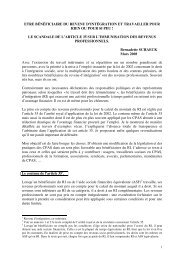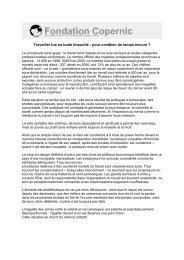Awra Amba RJ 300612 EN - Contacter un comité local d'Attac
Awra Amba RJ 300612 EN - Contacter un comité local d'Attac
Awra Amba RJ 300612 EN - Contacter un comité local d'Attac
You also want an ePaper? Increase the reach of your titles
YUMPU automatically turns print PDFs into web optimized ePapers that Google loves.
1. Method<br />
final conclusions of Mekonnen (2009) are not deduced from the data really presented in the<br />
text body and are not presented as personal viewpoints of the author.<br />
This violation of the scientific standards is not a formal question, but an indicator of the scientific<br />
quality sometimes questionable of the studies, these standards being a part of the scientific method<br />
ensuring the quality of the results. In this regard, studies of Atnafu and Yirga seem outstanding.<br />
Some studies intend to measure through survey behaviours, but only measure the perception of their<br />
behaviours by the interviewed people: for instance, the question "Are you beneficiary of mass<br />
media? 1.Yes 2.No" (Yassin, 2008, p. 93) cannot in any way assess the degree to which the<br />
interviewed people have real access to mass media and the degree to which they are beneficiary of<br />
them – it should for that purpose have asked for instance a closed question about the frequency of<br />
access to different mass media; This question only measures each one opinion on his own<br />
information, which gives an interesting information, but somewhat less reliable and notably vague.<br />
The relatively limited resources of the studies did not allow without doubt more comprehensive<br />
research. This relative weakness is especially present in Yassin (2008).<br />
Finally, as usually, neither the journalist reports, nor the personal acco<strong>un</strong>ts give generally their work<br />
method, which does not allow assessing their quality.<br />
1.3. Work method<br />
The four main sources coming from master studies have each a subject very well documented, but at<br />
the same time give a lot of other information on a wide variety of subjects. On given points, data can<br />
be contradictory; in that case, we present the different versions.<br />
In all the cases, we try to indicate accurately the source of the information given, for transparency. It<br />
leads to very numerous references. In order to make the text lighter, the four sources the most often<br />
cited are cited by using the following abbreviations: Jo10b instead of Joumard (2010b), At05 instead<br />
of Atnafu (2005), Yi07 instead of Yirga (2007), Ya08 instead of Yassin (2008) and Me09 instead of<br />
Mekonnen (2009) 1 .<br />
With a few exceptions, we do not put the text parts copied from the different references between<br />
quotation marks in order to make the reading easier. Nevertheless, most of the report merely repeats<br />
data and information coming from the literature: a paragraph including a reference can generally be<br />
attributed to this reference, even we have modified the wording.<br />
We express also own opinions of the author of this report, either through an independent paragraph<br />
without reference, or through text elements clearly attributed to the author by expressions like "In<br />
our opinion...". Pictures and figures are from the author, <strong>un</strong>less otherwise specified.<br />
The demonstration of contradictory versions according to authors as well as our own thoughts lead<br />
us to ask precise questions, more or less important, to which it is useful in our opinion to answer in<br />
the future. These questions are listed in Annex by order appearing in the text body, and they are<br />
referenced in the text body when appropriate.<br />
Moreover, the social transformations introduced in <strong>Awra</strong> <strong>Amba</strong> cannot be <strong>un</strong>derstood without<br />
reference to the Ethiopian society and more precisely to the Amhara society which <strong>Awra</strong> <strong>Amba</strong> is<br />
part of and where it comes from. We try therefore to present for that reason at the beginning of each<br />
subject the situation in the traditional Amhara society, before focussing on the situation in <strong>Awra</strong><br />
<strong>Amba</strong>.<br />
1 The number after "/" indicates the page ; Therefore, Yassin (2008/45) or Ya08/45 indicates the<br />
reference Yassin (2008), page 45.<br />
17 / 85

















